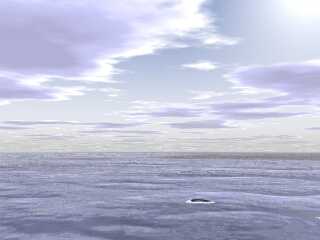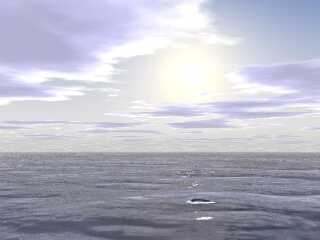 |
 |
|
 |
|
 |
|  |
|  |
|
 |
|
 |
|  |
|  |
|
 |
I'm sure someone has already tried this, but I haven't seen it yet, so
I'm bringing it here.
The cloud technique is fairly straight forward; a black hole warp is
used to displace shaded areas away from the light source. The pigment is
applied to a curved cloud plane and lit by ambient light. Although I was
using MegaPOV, the method does not depend on it.
The calculation sky colors based on sun elevation is sort of am
empirical hack. Not very straight forward, it still needs alot of work.
Anyway, the thing to look at is the lighting of the clouds in relation
to the sun.
Abe
P.S. The thing in the water on the lower right - don't ask me what it
is, I don't know. It just sort of showed up...thought it might be a
whale or something.
Post a reply to this message
Attachments:
Download 'warp_shade1.jpg' (49 KB)
Download 'warp_shade2.jpg' (48 KB)
Download 'warp_shade3.jpg' (51 KB)
Preview of image 'warp_shade1.jpg'

Preview of image 'warp_shade2.jpg'

Preview of image 'warp_shade3.jpg'

|
 |
|  |
|  |
|
 |
|
 |
|  |
|  |
|
 |
Those are probably the best single layer clouds I've seen. Looks just like
the clouds in Bryce.
-Mike
Post a reply to this message
|
 |
|  |
|  |
|
 |
|
 |
|  |
|  |
|
 |
That is beautiful. I've been fighting with my media clouds to get something
like that. The problem is that with absorption, the light fades off at some
point, and it doesn't look right. If we could somehow give your clouds some
more depth, they would be perfect.
Post a reply to this message
|
 |
|  |
|  |
|
 |
|
 |
|  |
|  |
|
 |
Abe wrote:
> The cloud technique is fairly straight forward; a black hole warp is
> used to displace shaded areas away from the light source. The pigment is
> applied to a curved cloud plane and lit by ambient light. Although I was
> using MegaPOV, the method does not depend on it.
Impressive: an English, I-haven't-touched-displacements-yet, explanation,
please?
Post a reply to this message
|
 |
|  |
|  |
|
 |
|
 |
|  |
|  |
|
 |
Perhaps utilize the layered planes (or spheres) trick. Of course, if you do
enough layers, you might as well use media at that point, due to speed
considerations.
--
Paul Vanukoff
"Tony[B]" <ben### [at] panama c-com c-com net> wrote in message
news:3986c727@news.povray.org...
> That is beautiful. I've been fighting with my media clouds to get
something
> like that. The problem is that with absorption, the light fades off at
some
> point, and it doesn't look right. If we could somehow give your clouds
some
> more depth, they would be perfect. net> wrote in message
news:3986c727@news.povray.org...
> That is beautiful. I've been fighting with my media clouds to get
something
> like that. The problem is that with absorption, the light fades off at
some
> point, and it doesn't look right. If we could somehow give your clouds
some
> more depth, they would be perfect.
Post a reply to this message
|
 |
|  |
|  |
|
 |
|
 |
|  |
|  |
|
 |
Abe wrote in message <398### [at] taconic net>...
>I'm sure someone has already tried this, but I haven't seen it yet, so
>I'm bringing it here.
>
>The cloud technique is fairly straight forward; a black hole warp is
>used to displace shaded areas away from the light source. The pigment is
>applied to a curved cloud plane and lit by ambient light. Although I was
>using MegaPOV, the method does not depend on it.
>
>The calculation sky colors based on sun elevation is sort of am
>empirical hack. Not very straight forward, it still needs alot of work.
>
>Anyway, the thing to look at is the lighting of the clouds in relation
>to the sun.
>
>Abe
Very nice. I like the first two the most. What pattern are you using for the
cloud layer? bozo?
Gail
********************************************************************
* gsh### [at] monotix net>...
>I'm sure someone has already tried this, but I haven't seen it yet, so
>I'm bringing it here.
>
>The cloud technique is fairly straight forward; a black hole warp is
>used to displace shaded areas away from the light source. The pigment is
>applied to a curved cloud plane and lit by ambient light. Although I was
>using MegaPOV, the method does not depend on it.
>
>The calculation sky colors based on sun elevation is sort of am
>empirical hack. Not very straight forward, it still needs alot of work.
>
>Anyway, the thing to look at is the lighting of the clouds in relation
>to the sun.
>
>Abe
Very nice. I like the first two the most. What pattern are you using for the
cloud layer? bozo?
Gail
********************************************************************
* gsh### [at] monotix co co za * Reality.dat not found *
* http://www.rucus.ru.ac.za/~gail/ * Attempting to reboot universe *
********************************************************************
* The best way to accelerate Windows NT is at 9.8 m/s^2 *
******************************************************************** za * Reality.dat not found *
* http://www.rucus.ru.ac.za/~gail/ * Attempting to reboot universe *
********************************************************************
* The best way to accelerate Windows NT is at 9.8 m/s^2 *
********************************************************************
Post a reply to this message
|
 |
|  |
|  |
|
 |
|
 |
|  |
|  |
|
 |
Beautiful. Share the source, please, because this is really really nice. What
is the render time?
Josh
Abe wrote:
> I'm sure someone has already tried this, but I haven't seen it yet, so
> I'm bringing it here.
>
> The cloud technique is fairly straight forward; a black hole warp is
> used to displace shaded areas away from the light source. The pigment is
> applied to a curved cloud plane and lit by ambient light. Although I was
> using MegaPOV, the method does not depend on it.
>
> The calculation sky colors based on sun elevation is sort of am
> empirical hack. Not very straight forward, it still needs alot of work.
>
> Anyway, the thing to look at is the lighting of the clouds in relation
> to the sun.
>
> Abe
>
> P.S. The thing in the water on the lower right - don't ask me what it
> is, I don't know. It just sort of showed up...thought it might be a
> whale or something.
>
> ------------------------------------------------------------------------
> [Image] [Image] [Image]
--
Josh English -- Lexiphanic Lethomaniac
eng### [at] spiritone com
The POV-Ray Cyclopedia http://www.spiritone.com/~english/cyclopedia/ com
The POV-Ray Cyclopedia http://www.spiritone.com/~english/cyclopedia/
Post a reply to this message
|
 |
|  |
|  |
|
 |
|
 |
|  |
|  |
|
 |
Abe wrote:
> Anyway, the thing to look at is the lighting of the clouds in relation
> to the sun.
Very interesting. I think the interaction of clouds (as a curved plane)
and sun is remarkable!
Karl
Post a reply to this message
|
 |
|  |
|  |
|
 |
|
 |
|  |
|  |
|
 |
I think the same. Gorgeous pictures !
I rendered once (upon a time a picture with a media sky that took a whole week to
render on my former K6-200)
Now that I think of it, maybe I should try with the Duron.
> Beautiful. Share the source, please, because this is really really nice. What
> is the render time?
> Josh
>
> Abe wrote:
>
> > I'm sure someone has already tried this, but I haven't seen it yet, so
> > I'm bringing it here.
> >
> > The cloud technique is fairly straight forward; a black hole warp is
> > used to displace shaded areas away from the light source. The pigment is
> > applied to a curved cloud plane and lit by ambient light. Although I was
> > using MegaPOV, the method does not depend on it.
> >
> > The calculation sky colors based on sun elevation is sort of am
> > empirical hack. Not very straight forward, it still needs alot of work.
> >
> > Anyway, the thing to look at is the lighting of the clouds in relation
> > to the sun.
> >
> > Abe
> >
> > P.S. The thing in the water on the lower right - don't ask me what it
> > is, I don't know. It just sort of showed up...thought it might be a
> > whale or something.
> >
> > ------------------------------------------------------------------------
> > [Image] [Image] [Image]
>
> --
> Josh English -- Lexiphanic Lethomaniac
> eng### [at] spiritone com
> The POV-Ray Cyclopedia http://www.spiritone.com/~english/cyclopedia/ com
> The POV-Ray Cyclopedia http://www.spiritone.com/~english/cyclopedia/
Post a reply to this message
|
 |
|  |
|  |
|
 |
|
 |
|  |
|  |
|
 |
Displacement is probably the wrong term to use here. Consider it like
this: make a standard bozo texture cloud which has light edges and is
dark in the middle. However, to be more realistic, the edges should be
lighter on the side closer to the sun and darker on the farther side. I
tried to accomplish this by pushing the darker middle part away from the
light source.
Specifically, I used a inverse black hole warp centered on the sun to
offset the darker portions of the clouds.
Hope this helps.
Abe
"Greg M. Johnson" wrote:
> Impressive: an English, I-haven't-touched-displacements-yet, explanation,
> please?
Post a reply to this message
|
 |
|  |
|  |
|
 |
|
 |
|  |




![]()